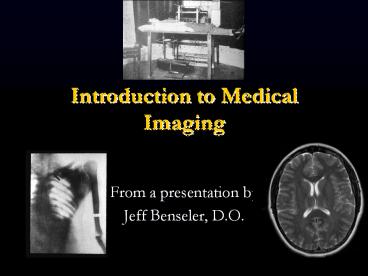Introduction to Medical Imaging - PowerPoint PPT Presentation
1 / 27
Title:
Introduction to Medical Imaging
Description:
Introduction to Medical Imaging From a presentation by Jeff Benseler, D.O. Objectives How do x-rays create an image of internal body structures? – PowerPoint PPT presentation
Number of Views:214
Avg rating:3.0/5.0
Title: Introduction to Medical Imaging
1
Introduction to Medical Imaging
- From a presentation by
- Jeff Benseler, D.O.
2
Objectives
- How do x-rays create an image of internal body
structures? - What are the 5 basic radiographic densities?
- Try your hand at interpreting several medical
imaging cases.
3
List of diagnostic imaging studies
- Plain x-rays
- CT scan
- MRI
- Nuclear imaging/PET
- Ultrasound
- Mammography
- Angiography
- Fluoroscopy
Which of these modalities use ionizing radiation?
4
What are x-rays?
- No mass
- No charge
- Energy
What is your diagnosis?
5
Basic x-ray physics
- X-rays a form of electromagnetic energy
- Travel at the speed of light
- Electromagnetic spectrum
- Gamma Rays
- X-rays
- Visible light
- Infrared light
- Microwaves
- Radar
- Radio waves
6
Three things can happen
- X-rays can
- Pass all the way through the body
- Be deflected or scattered
- Be absorbed
Where on this image have x-rays passed through
the body to the greatest degree?
7
X-rays Passing Through Tissue
- Depends on the energy of the x-ray and the atomic
number of the tissue - Higher energy x-ray - more likely to pass through
- Higher atomic number - more likely to absorb the
x-ray
Diagnosis?
8
How do x-rays passing through the body create an
image?
- X-rays that pass through the body to the film
render the film dark (black) - X-rays that are totally blocked do not reach the
film and render the film light (white) - Air low atomic x-rays get through image
is dark - Metal high atomic x-rays blocked image is
light (white)
9
5 Basic Radiographic Densities
1.
- Air
- Fat
- Soft tissue/fluid
- Mineral
- Metal
4.
5.
2.
3.
Name these radiographic densities.
10
History I think my dog swallowed a rock
Diagnosis Yes, he did.
11
Diagnosis?
12
(No Transcript)
13
Can you recognize shapes and density?
14
Find the pathology What clues do you have?
15
Medical Imaging
- Primary purpose is to identify pathologic
conditions. - Requires recognition of normal anatomy.
16
History 11 y/o twisting injury of the foot
17
(No Transcript)
18
Naming the parts of a long bone
Distal
3.
2.
1.
Proximal
Word bank epiphysis, metaphysis, diaphysis,
cortex, medullary cavity
19
Summary How do x-rays create an image of
internal body structures?
- X-rays pass through the body to varying degrees
- Higher atomic number structures block x-rays
better, example bone. - Lower atomic number structures allow x-rays to
pass through, example air in the lungs.
Question If x-rays were blocked to the same
degree by all body structures, could we see the
internal parts of the body?
20
What are the 5 basic radiographic densities from
black to bright white?
- Air
- Fat
- Soft tissue/fluid
- Bone/mineral
- Metal
21
What density are the lungs?
Why?
The list air, fat, soft tissue, mineral and metal
22
air
CT scan of the abdomen
X-rays used
skin
What density is this?
23
Di
Diagnosis?
24
Radiographic Analysis
- Any structure, normal or pathologic, should be
analyzed for - Size
- Shape and contour
- Position
- Density (You must know the 5 basic densities)
25
The anatomical position
left
right
26
What density is this?
27
Summary questions
- What 3 things when an x-ray encounters the body?
- How is it possible to see the heart on an x-ray?
- What are the 5 basic radiographic densities?
- What three things can you do to protect yourself
from radiation?

